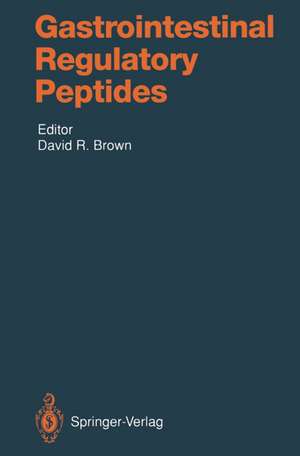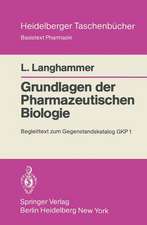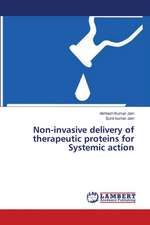Gastrointestinal Regulatory Peptides: Handbook of Experimental Pharmacology, cartea 106
Editat de David R. Brown Contribuţii de A. Alemayehu, B. Amiranoff, D.L. Barber, S.R. Bloom, J. Calam, R.E. Carraway, Feng Chen, C.S. Chew, C.C. Chou, J.M. Conlon, A. Couvineau, E. Ekblad, T.S. Gaginella, J.J. Galligan, J.R. Grider, R. Hakanson, P. Kitabgi, M. Laburthe, Y.P. Loh, M.S. O'Dorisio, S.M. O'Grady, R.K. Pearson, R.J. Playford, E. Rozengurt, F. Sundler, I. Zacharyen Limba Engleză Paperback – 16 dec 2011
Din seria Handbook of Experimental Pharmacology
- 5%
 Preț: 3517.78 lei
Preț: 3517.78 lei - 5%
 Preț: 1425.97 lei
Preț: 1425.97 lei - 5%
 Preț: 1435.28 lei
Preț: 1435.28 lei - 5%
 Preț: 1430.52 lei
Preț: 1430.52 lei - 5%
 Preț: 1930.69 lei
Preț: 1930.69 lei - 5%
 Preț: 1922.47 lei
Preț: 1922.47 lei - 5%
 Preț: 1937.46 lei
Preț: 1937.46 lei - 5%
 Preț: 2117.58 lei
Preț: 2117.58 lei - 5%
 Preț: 2119.96 lei
Preț: 2119.96 lei - 5%
 Preț: 2117.38 lei
Preț: 2117.38 lei - 5%
 Preț: 1088.15 lei
Preț: 1088.15 lei - 5%
 Preț: 1098.27 lei
Preț: 1098.27 lei - 5%
 Preț: 1420.29 lei
Preț: 1420.29 lei - 5%
 Preț: 1104.84 lei
Preț: 1104.84 lei - 5%
 Preț: 1104.84 lei
Preț: 1104.84 lei - 5%
 Preț: 1108.14 lei
Preț: 1108.14 lei - 5%
 Preț: 1106.69 lei
Preț: 1106.69 lei - 5%
 Preț: 1105.77 lei
Preț: 1105.77 lei - 5%
 Preț: 1174.35 lei
Preț: 1174.35 lei - 5%
 Preț: 408.48 lei
Preț: 408.48 lei - 5%
 Preț: 409.63 lei
Preț: 409.63 lei - 5%
 Preț: 539.89 lei
Preț: 539.89 lei - 5%
 Preț: 720.47 lei
Preț: 720.47 lei - 5%
 Preț: 733.09 lei
Preț: 733.09 lei - 5%
 Preț: 731.27 lei
Preț: 731.27 lei - 5%
 Preț: 746.43 lei
Preț: 746.43 lei - 5%
 Preț: 747.72 lei
Preț: 747.72 lei - 5%
 Preț: 742.80 lei
Preț: 742.80 lei - 5%
 Preț: 393.23 lei
Preț: 393.23 lei - 5%
 Preț: 735.66 lei
Preț: 735.66 lei - 5%
 Preț: 728.33 lei
Preț: 728.33 lei - 5%
 Preț: 389.52 lei
Preț: 389.52 lei - 5%
 Preț: 730.71 lei
Preț: 730.71 lei - 5%
 Preț: 740.58 lei
Preț: 740.58 lei - 5%
 Preț: 730.19 lei
Preț: 730.19 lei - 5%
 Preț: 723.42 lei
Preț: 723.42 lei - 5%
 Preț: 731.27 lei
Preț: 731.27 lei - 5%
 Preț: 726.68 lei
Preț: 726.68 lei - 5%
 Preț: 3516.49 lei
Preț: 3516.49 lei - 5%
 Preț: 729.26 lei
Preț: 729.26 lei - 5%
 Preț: 737.11 lei
Preț: 737.11 lei - 5%
 Preț: 730.92 lei
Preț: 730.92 lei - 5%
 Preț: 738.78 lei
Preț: 738.78 lei - 5%
 Preț: 909.94 lei
Preț: 909.94 lei - 5%
 Preț: 720.10 lei
Preț: 720.10 lei - 5%
 Preț: 734.74 lei
Preț: 734.74 lei - 5%
 Preț: 727.80 lei
Preț: 727.80 lei - 5%
 Preț: 3513.38 lei
Preț: 3513.38 lei
Preț: 725.24 lei
Preț vechi: 763.40 lei
-5% Nou
Puncte Express: 1088
Preț estimativ în valută:
138.77€ • 144.89$ • 114.85£
138.77€ • 144.89$ • 114.85£
Carte tipărită la comandă
Livrare economică 04-18 aprilie
Preluare comenzi: 021 569.72.76
Specificații
ISBN-13: 9783642778162
ISBN-10: 364277816X
Pagini: 472
Ilustrații: XX, 446 p.
Dimensiuni: 155 x 235 x 25 mm
Greutate: 0.65 kg
Ediția:Softcover reprint of the original 1st ed. 1993
Editura: Springer Berlin, Heidelberg
Colecția Springer
Seria Handbook of Experimental Pharmacology
Locul publicării:Berlin, Heidelberg, Germany
ISBN-10: 364277816X
Pagini: 472
Ilustrații: XX, 446 p.
Dimensiuni: 155 x 235 x 25 mm
Greutate: 0.65 kg
Ediția:Softcover reprint of the original 1st ed. 1993
Editura: Springer Berlin, Heidelberg
Colecția Springer
Seria Handbook of Experimental Pharmacology
Locul publicării:Berlin, Heidelberg, Germany
Public țintă
Professional/practitionerCuprins
1 Localization and Colocalization of Gastrointestinal Peptides.- A. Introduction.- B. Coexistence of Messengers.- C. Endocrine and Paracrine Cells.- D. Enteric Neurons.- References.- 2 Regulation of Gastrointestinal Peptide Hormone Gene Expression.- A. Introduction.- B. Gene Structure.- C. RNA Polymerase II.- D. Transcriptional Regulation Overview.- E. Analysis of Gene Expression.- F. Regulation of Specific Hormone Gene Expression.- G. Conclusion.- References.- 3 Post-Translational Processing of Regulatory Peptides.- A. Introduction.- B. General Design of Processing Systems.- C. Intracellular Trafficking and Processing Pathways.- D. Processing Sites and General Mechanisms.- E. Enzymes Involved in the Processing of Prohormones.- F. Processing of Specific Prohormones.- G. Conclusion.- References.- 4 Regulation of Peptide Secretion from Gastroenteric Endocrine Cells.- A. Introduction.- B. Gastroenteric Endocrine Cells.- C. Neurotransmitter and Peptide Regulation of Release.- D. Nutrient Regulation of Peptide Release.- E. Regulation of Release by Luminal pH.- F. Summary.- References.- 5 Peptide Receptors and Signal Transduction in the Digestive Tract.- A. Introduction.- B. General Considerations and Methodology.- C. Signal Transduction by Receptors.- D. Peptide Receptors in the Digestive Tract.- E. Conclusion and Perspectives.- References.- 6 Proteolytic Inactivation of Neurohormonal Peptides in the Gastrointestinal Tract.- A. Introduction.- B. Proteolytic Enzymes Implicated in the Inactivation of Neurohormonal Peptides in the Gastrointestinal Tract.- C. Pathways of Proteolytic Inactivation of Some Gastrointestinal Hormones.- D. Pathways of Proteolytic Inactivation of Some Gastrointestinal Neuropeptides.- E. Conclusion.- References.- 7 Peptidergic Regulation of Gastric AcidSecretion.- A. Introduction.- B. Acid Secretory Control Mechanisms In Vivo.- C. Peptide Effects on Isolated Cells.- References.- 8 Peptides and Enteric Neural Activity.- A. Introduction.- B. Electrophysiology of Enteric Nerves.- C. Actions of Peptides on Enteric Nerves.- D. Conclusions.- References.- 9 Peptidergic Regulation of Smooth Muscle Contractility.- A. Introduction.- B. Regulation of Smooth Muscle by Peptide Hormones.- C. Regulation of Smooth Muscle by Neural Peptides.- References.- 10 Peptidergic Regulation of Intestinal Electrolyte Transport.- A. Introduction.- B. Transport Models for Absorption and Secretion.- C. Regulation of Intestinal Transport by Peptide Neurohormones.- D. Concluding Remarks.- References.- 11 Peptidergic Regulation of Gastrointestinal Blood Flow.- A. Introduction.- B. Gastrointestinal Peptides.- C. Capsaicin-Sensitive Afferent Nerves.- References.- 12 Peptidergic Regulation of Cell Proliferation Through Multiple Signaling Pathways.- A. Introduction.- B. Growth-Promoting Activities of Neuropeptides in Cultured Cells.- C. Early Signaling Events.- D. Evidence for Growth-Promoting Effects of Neuropeptides In Vivo.- E. Conclusions.- References.- 13 Peptidergic Regulation of Mucosal Immune Function.- A. Introduction.- B. Overview of Immune Function in Gut-Associated Lymphoid Tissue.- C. Peptide Effects on Immune Function.- D. Conclusion.- References.- 14 Pathophysiological Aspects of Gut Peptide Hormones.- A. Introduction.- B. Esophagus.- C. Stomach.- D. Duodenum.- E. Pancreas.- F. Gallstones.- G. Small Bowel.- H. Colon.- J. Gastrointestinal Hormones and Cardiovascular Function.- K. Conclusions.- References.- 15 Gastrointestinal Peptides as Therapeutic Agents and Targets: Past, Present and Future.- A. Introduction.- B. Diagnostic Use of Gastrointestinal Peptides.- C. Peptides as Agonists in Therapeutics.- D. Antagonists of Peptides in Therapy.- E. The Future.- References.





















